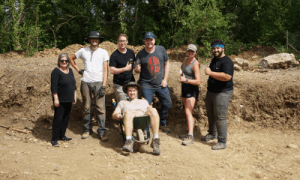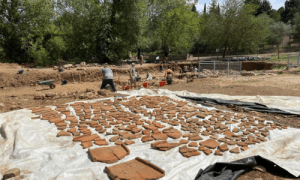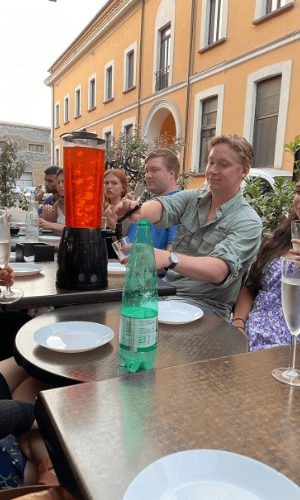For the first time in two years, a group of six Saint Anselm students traveled to participate in the Archaeological Field School at Coriglia in Italy. No previous archeology knowledge was required, as part of the field school includes learning how to properly use equipment and identify artifacts. Kylee Royer ‘23, a forensic science major, went on the trip with little background information and still enjoyed the full learning experience. “All of the supervisors loved educating us and were very good at actually helping us learn,” Royer said.

Coriglia is located right outside of Orvieto, Italy. Thanks to a 1.2-million-euro EU restoration grant, the site has been transformed into an archaeological park since their last visit. “Our focus this season was Trench A, one of the oldest trenches on the site which the Commune of Castel Viscardo helped us expand for the summer 2022 season,” said Professor Linda Rulman, Director of Saint Anselm College Orvieto, Classics.
The site is home to material from Greek, Etruscan, Roman as well as medieval and renaissance Italian cultures dating from 1000 BCE to 1400 CE. “Specifically, the site is concerned with finding the purpose and reason behind the existence of a Roman bath complex and how the Romans interacted with the Etruscans, as the site is located along the way to the main center of the Etruscan religion,” explained Connor O’Neill ‘22, a history major with minors in Latin and politics.
Students digging in trench A south, where there is a late Roman road and a channel once used for water, found a variety of Roman objects. They also discovered a wall at the south edge, which the team concluded meant the area was previously a large vasca (basin for water) that contained thermal waters. “The ancient Etruscans and Romans often consecrated thermal springs and developed them into popular resort spas dedicated to water nymphs,” explained Professor Rulman.

Trench A north, which was part of the expansion, held a large pile of Etruscan roof tiles and pottery. Since there was nothing significant below them, the team concluded that these were the remains of a collapsed roof. As they continued digging, wondering where the building once was, they discovered a wall to the north of the water channel which could be the location where the original roof once stood. This discovery came on the last day of the dig, so further investigation will be done next season. Connor O’Neill was part of the group that discovered the roof while searching for a drain from the Roman baths. “This was highly intriguing as it was unexpected and further lends credence to the connection and interaction between the two peoples,” he said.
“This season’s finds further our hypothesis that Coriglia with its abundance of water features contained an ancient healing sanctuary dating back to the Etruscans and in continual use by the Romans into the 4th/5th centuries CE,” Professor Rulman stated.
Since 2006, groups of students have traveled to the excavation site at Coriglia. Students participating in the field school spend time digging in the field, working in the lab, attending lectures, and keeping a field journal. Excavations typically run Monday through Friday from 8:00 am to 5:30 pm with an hour for lunch in the field. “The convent life was simple, but something I wouldn't take for granted now,” said Royer. “It was a stress-free environment of just waking up and going to dig and then doing it all over again. I enjoyed every second and would definitely go back,” she continued.

Outside of the site, students can experience all of the historic and cultural attractions that Orvieto has to offer, such as visiting the Duomo, sampling wild boar, or celebrating the Festa del Corpus Domini. Students also explored other areas of the country, such as Rome, Pisa, Arezzo, Naples, and Pompeii. “Castel Viscardo, the commune that hosts the excavation, put on a dinner for us after the excavation presentation that lasted past midnight,” Professor Rulman said. The group spent hours together sharing local specialties which included porchetta.
The team returned safely to the United States at the end of June, heads full of new knowledge and unforgettable memories. Kylee Royer described the trip as one of the coolest things she has ever done, citing the quality of learning and lifelong bonds between the participants as some of her reasoning. Connor O’Neill shared similar sentiments. “I found the experience to be eye-opening, as I participated in a one-of-a-kind experience, learning about the past through the excavation of historical artifacts,” he said.
The team returned safely to the United States at the end of June, heads full of new knowledge and unforgettable memories. Kylee Royer described the trip as one of the coolest things she has ever done, citing the quality of learning and lifelong bonds between the participants as some of her reasoning. Connor O’Neill shared similar sentiments. “I found the experience to be eye-opening, as I participated in a one-of-a-kind experience, learning about the past through the excavation of historical artifacts,” he said.
